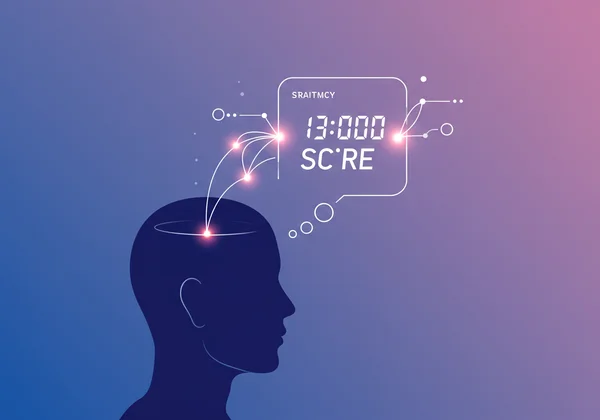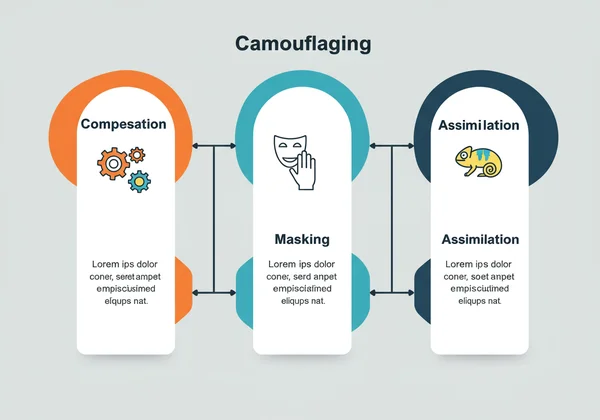CATQ Score Interpretation: What a High Score Means for Autistic Masking
Feeling a bit lost in the numbers after taking the Camouflaging Autistic Traits Questionnaire (CATQ)? You're not alone. This guide will demystify your results, offering a clear, compassionate path to understanding your unique camouflaging patterns. If you've ever asked yourself, "How do I know if I'm masking autism?", your score is a great starting point, and this article will help you interpret the map of your social world. Let's begin your CATQ journey.
Understanding Your CATQ Score: The Basics of Interpretation
A CATQ score is more than just a number; it’s a reflection of the energy you might be using to navigate social situations. The questionnaire, developed by Hull et al. in 2018, is a scientifically validated tool designed to quantify the strategies autistic and non-autistic people use to "fit in." Think of your score not as a grade, but as a data point on your path to self-understanding. It helps validate feelings of exhaustion or of "acting a part" that so many people, especially those exploring neurodiversity later in life, experience.

How the CATQ is Scored & What the Total Means
The questionnaire consists of 25 questions, each rated on a scale of 1 to 6. This results in a total score ranging from 25 to 150. In the simplest terms, a higher total score suggests a greater frequency and intensity of camouflaging behaviors. It indicates that you may often find yourself consciously or subconsciously adjusting your natural behaviors to meet perceived social expectations.
This isn't inherently good or bad; it's simply information. For many, seeing this quantified for the first time is an incredibly validating experience. It provides a name for the lifelong feeling of being a "social chameleon" and the exhaustion that comes with it. The score acknowledges the hard work you've been doing just to get through the day. To see where you stand, you can take the free CATQ test.
Deconstructing the Three Pillars of Camouflaging (Compensation, Masking, Assimilation)
Your total score is just the beginning. The real depth of the assessment lies in its three sub-scales, which represent the different facets of camouflaging. Understanding your scores in each of these areas provides a much richer picture of your personal strategies.

-
Compensation: This is the strategic pillar. Compensation involves learning social rules and scripts to "compensate" for any innate difficulties in social intuition. Have you ever watched TV shows to memorize how people express emotions? Or practiced conversations in your head before a phone call? These are classic autism compensation strategies. It's the proactive work you do behind the scenes to prepare for social interactions.
-
Masking: This pillar is about suppression. Masking is the conscious effort to hide or control natural behaviors that might be viewed as socially "unacceptable." This can include forcing eye contact even when it's uncomfortable, suppressing stims like hand-flapping or leg-jiggling, or hiding your intense interest in a specific topic to avoid overwhelming others. It's the act of putting on a "neurotypical mask," which can be incredibly draining. Many people seek an autistic masking test precisely to understand this phenomenon.
-
Assimilation: This is the adaptive pillar, focused on fitting in during real-time social situations. Assimilation involves mimicking the behaviors, mannerisms, and speech patterns of others to blend into a group. You might find yourself mirroring someone's posture or adopting their accent without realizing it. It's about trying to become indistinguishable from your peers to avoid standing out. This is a core part of the masking vs assimilation autism dynamic.
By looking at your scores for each pillar, you can see your unique camouflaging profile. Are you a meticulous planner (high Compensation), a careful suppressor (high Masking), or a social mirror (high Assimilation)? Most people use a combination of all three. You can explore your unique profile with a CATQ assessment.
What Constitutes a High CATQ Score & Its Implications
So, you have your scores. Now for the big question: what is considered a high score? While there's no magic number that serves as a formal diagnosis, research provides us with some useful benchmarks for interpretation. A high score is a powerful indicator of the mental and emotional effort you're expending, and understanding its implications is a crucial step toward preventing burnout.
Navigating CATQ Score Ranges and Common Thresholds
The original research by Hull et al. found that autistic adults scored significantly higher on the assessment than non-autistic adults. In their study, the average score for autistic individuals was around 114, while the average for non-autistic individuals was closer to 80. A common research threshold used to indicate significant camouflaging is a total score of 100 or above.
If your score is above this threshold, it may suggest that you engage in camouflaging behaviors at a level common among autistic individuals. However, it's critical to understand that this is not a diagnostic catq cut off score. Many non-autistic individuals with social anxiety or those from minority cultures may also score highly. This score is a clue, a piece of the puzzle that is you.
The Nuance Beyond the Number: Why Individual Context Matters
Your CATQ score cannot be interpreted in a vacuum. A high score for one person might feel like a survival mechanism, while for another, it might feel like a chosen strategy. Context is everything. For many with undiagnosed autism in adults, particularly women and LGBTQ+ individuals, a high score can be the first concrete piece of evidence that explains a lifetime of feeling different.
A high score often correlates with significant life challenges. The constant effort of camouflaging is a leading cause of autistic burnout—a state of profound exhaustion that impacts every area of life. It can also contribute to anxiety, depression, and a diminished sense of self. Recognizing that your high score reflects immense effort is the first step toward giving yourself permission to rest and unmask in safe environments.

Your Next Steps After Receiving CATQ Results
Receiving your score is not the end of your journey; it’s the beginning of a new chapter of self-discovery. The results are a tool to empower you with knowledge. Here’s how you can use that knowledge to move forward in a way that feels authentic and sustainable for you.
Leveraging Your AI Personalized Report for Deeper Insights
While the numbers are insightful, the true power of your CATQ results can be unlocked with deeper analysis. On our platform, we offer an optional AI personalized report that goes far beyond the standard scores. This unique tool analyzes your specific answers to the 25 questions, not just the final numbers, to provide a detailed narrative of your camouflaging style.

The report identifies your personal strengths (like your incredible ability to learn patterns), your challenges, and how your camouflaging behaviors might be impacting you in real-life scenarios—at work, in friendships, and in relationships. It offers actionable advice tailored to your profile, helping you find a healthier balance between fitting in and being your true self. To see what this looks like, you can unlock your report.
When to Consider Professional Consultation for Deeper Understanding
Remember, the CATQ is a self-assessment tool, not a substitute for a professional medical diagnosis. Your results can be an invaluable resource to bring to a therapist, psychologist, or other qualified professional, especially one who specializes in adult autism and neurodiversity.
Sharing your score and your AI report can provide a fantastic starting point for a diagnostic evaluation or therapeutic support. A professional can help you explore your results in the context of your full life history, rule out other possibilities, and develop strategies for managing burnout and cultivating a more authentic life. You can find resources from organizations like the Autism Research Institute or use directories like Psychology Today to locate qualified professionals. Find out more at the official CATQ site.
Empowering Your Self-Discovery Journey with CATQ
Interpreting your CATQ score is a profound act of self-discovery. It’s about validating your experiences, understanding the immense effort you’ve put into navigating the world, and recognizing that you have choices. A high score isn’t a judgment; it’s an invitation to explore a more authentic, less exhausting way of being.
Whether you've just received your score or are curious to learn more, your journey is valid. We encourage you to use the resources available, from our free catq online test to our in-depth AI report and support from groups like the Autistic Self Advocacy Network, to support your exploration.
What did you discover from your score? Share your thoughts or questions in the comments below—your experience might be exactly what someone else needs to read today.
Frequently Asked Questions About CATQ Scores
What is considered a high score on the CATQ?
A score of 100 or above is often considered a threshold in research studies to indicate significant levels of autistic camouflaging. However, this is not a definitive "cut-off" and should be interpreted within your personal context. It suggests that you may be using camouflaging strategies more frequently and intensely than the general population.
Is there a specific "cut-off" score for the CATQ to indicate autism?
No, there is no official diagnostic cut-off score. The CATQ is a tool for measuring camouflaging behaviors, not for diagnosing autism. While autistic individuals tend to score higher, a high score alone is not a diagnosis. It should be used as a tool for self-reflection and as a potential starting point for a discussion with a healthcare professional.
How accurate and reliable is the CATQ test for self-assessment?
The CATQ is considered a scientifically validated and reliable instrument for measuring autistic camouflaging, as established by its creators (Hull et al., 2018). When used for self-assessment, it provides a dependable snapshot of your social strategies. The CATQ test online on our site uses the complete, official questionnaire to ensure accuracy.
What's the difference between masking, camouflaging, and compensation?
Camouflaging is the umbrella term for all strategies used to hide or disguise autistic traits. Masking and Compensation are two of the three main types of camouflaging:
- Masking: Hiding or suppressing natural behaviors (e.g., stopping yourself from stimming).
- Compensation: Pre-planning social behaviors (e.g., rehearsing scripts for conversations).
- Assimilation: Imitating others in real-time to blend in.